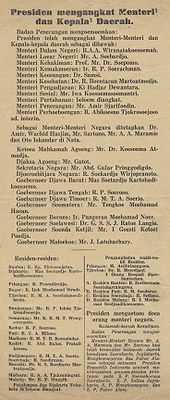Presidential Cabinet (Indonesia)
The Presidential Cabinet (Indonesian: Kabinet Presidensial) was the first cabinet established by Indonesia following the 17 August 1945 Indonesian Declaration of Independence. It comprised 20 ministers and four officials. Its term of office ran from 2 September to 14 November 1945.
Background

Indonesian had been under Japanese occupation since 1942, but by 1943, realizing they were losing the war, the Japanese appointed Indonesian advisors (sanyo) to the administration and appointed nationalist leader Sukarno leader of a new Central Advisory Board (Chuo Sani-kai) in Jakarta[1]On 7 August, the day after the atomic bombing of Hiroshima, the Preparatory Committee for Indonesian Independence (Indonesian: Panitia Persiapan Kemerdekaan Indonesia) or PPKI was established. Sukarno was chairman, and Hatta vice-chairman. On 19 August 1945, this body created 12 ministries for Indonesia's first cabinet. The cabinet as formed contained sanyo as well as officials who had not worked with the Japanese. The cabinet was responsible to President Sukarno.[2][3]
Composition
President
- President: Sukarno
- Vice-president: Mohammad Hatta
Departmental Ministers
- Minister of Home Affairs: Raden Adipati Aria Muharam Wiranatakusumah
- Deputy Minister of Home Affairs: Harmani
- Minister of Foreign Affairs: Achmad Subardjo
- Minister of People's Security: Soeprijadi
- Minister of Justice: Professor Soepomo
- Minister of Finance: Dr Samsi
- Minister of Education: Ki Hadjar Dewantara
- Minister of Health: Dr. Boentaran Martoatmodjo
- Minister of Social Affairs: Iwa Kusuma Sumantri
- Minister of Information: Amir Sjarifuddin
- Deputy Minister of Information: Ali Sastroamidjojo
- Minister of Communications: Abikusno Tjokrosujuso
- Minister of Welfare: R.P. Soerachman
- Minister of Public works: Abikusno Tjokrosujuso
State Ministers (without portfolio)
- State Minister: Mohammad Amir
- State Minister: Wahid Hasyim
- State Minister: Sartono
- State Minister: A.A. Maramis
- State Minister: Oto Iskandar di Nata
Officials With the Rank of Minister
- Chairman of the Supreme Court: Dr. Koesoema Atmadja
- Attorney General: Gatot Tarunamihardja
- State Secretary: Abdoel Affar Pringgodigdo
- State Spokesman: Soekarjo Wirjopranoto
Changes
On 22 September 1945, Finance Minister Samsi was replaced by A.A. Maramis on health grounds. In a government decree on 6 October, Soeprijadi, a hero of the Blitar rebellion against the occupying Japanese, was officially appointed defense minister. However as no news was ever heard of him, on 20 October Muhammad Soeljoadikusuma was appointed ad interim defense minister. Attorney General Gatot Tarunamihardja resigned on 24 October. As a temporary measure, Supreme Court chairman Koesoema Atmadjawas appointed acting attorney general. Kasman Singodiedjo was appointed to the post on 7 November.
The end of the cabinet
On 11 November 1945, the Central Indonesian National Committee, which was the de facto legislature, demanded the cabinet be responsible to it, not to President Sukarno. Sukarno agreed to this and dismissed the cabinet.[4]
References
- Kahin, George McTurnan (1952) Nationalism and Revolution in Indonesia Cornell University Press, ISBN 0-8014-9108-8
- Ricklefs (1982), A History of Modern Indonesia, Macmillan Southeast Asian reprint, ISBN 0-333-24380-3
- Simanjuntak, P. N. H. (2003), Kabinet-Kabinet Republik Indonesia: Dari Awal Kemerdekaan Sampai Reformasi (in Indonesian), Jakarta: Djambatan, pp. 15–23, ISBN 979-428-499-8.
Notes
| ||||||||||||||||||||||||
